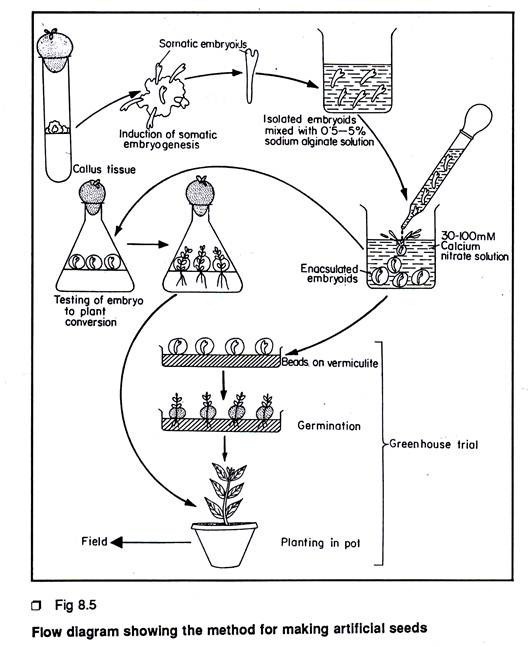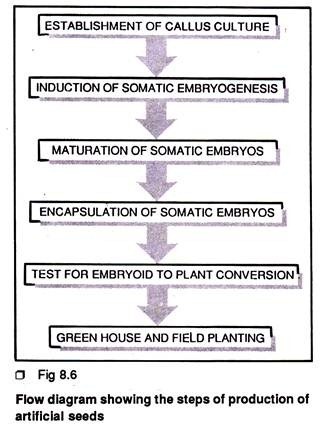Let us make an in-depth study of the meaning, method for making artificial seeds and importance of artificial seeds.
What are Artificial Seeds?
Artificial seeds are the living seed-like structure which are made experimentally by a technique where somatic embryoids derived from plant tissue culture are encapsulated by a hydrogel and such encapsulated embryoids behave like true seeds if grown in soil and can be used as a substitute of natural seeds.
Method for Making Artificial Seeds:
Several steps are followed for making artificial seeds:
(1) Establishment of callus culture
(2) Induction of somatic embryogenesis in callus culture
(3) Maturation of somatic embryos
(4) Encapsulation of somatic embryos
After encapsulation, the artificial seeds are tested by two steps:
(1) Test for embryoid to plant conversion
(2) Green-house and field planting.
Maturation of somatic embryos means the completion of embryo development through some stages. Initially, embryo develops as globular-shaped stage, then heart-shaped stage and finally torpedo-shaped stage. In the final stage, embryo attains maturity and develops the opposite poles for shoot and root development at the two extremities.
This embryo then starts to germinate and produces plantlet. However, in some plant species, such sequential development may not be followed. Again, in some species requiring cold treatment for embryo germination, it may be necessary to chill young or mature embryos for their normal maturation and development into plantlets.
Application of GA3 is also required for root and shoot development during embryo germination in citrus. Water soluble hydrogels have been found suitable for making artificial seeds. A list of some useful hydrogels for encapsulation of somatic embryos are given in Table 8.1.
Two standardized methods have been used to coat somatic embryos:
(i) Gel complexation via a dropping procedure;
(ii) Molding.
In the first method, isolated somatic embryos are mixed with 0.5 to 5% (W/V) Sodium alginate and dropped into 30-100 µM Calcium nitrate solution. Surface complexation begins immediately and the drops are gelled completely within 30 minutes (Fig 8.5).
In the second method, isolated somatic embryos are mixed in a temperature-dependent gel such as Gel-rite and placed in the well of a micro-titer plate and it forms gel when the temperature is cooled down.
To achieve the satisfactory results, research is required in several areas for making artificial seeds. Somatic embryos need to be produced on a large scale, matured to a stage where germination will be at a high rate and frequency and encapsulated embryos will probably need to be coated to prevent capsule desiccation and allow for singulation during planting.
After encapsulation, initially, the effect of coating on somatic embryos is very difficult to assess because the germination and continued development of the encapsulated embryos are sometimes very inconsistent after planting into soil.
So, to overcome this problem, embryo response in terms of embryo to plant development or conversion is tested under aseptic conditions. Embryo conversion frequency is the percent of the somatic embryos that produce green-plants having a normal phenotype.
Embryo to plant conversion includes the following steps:
(i) Encapsulated embryos are placed aseptically on simply agar medium with minimal nutrients.
(ii) Uniform germination of somatic embryos and growth and development of root and shoot systems.
(iii) Production of true leaves.
(iv) Absence of hypstrophy of the hypocotyl.
(v) A green-plant with a normal phenotype.
This assay should be very critical before showing the artificial seed in green-house or in the field. Otherwise, some modifications are to be required. The final assessment will be the green-house or field performance of artificial seed and their yield in comparison to plants derived from true seeds.
Storage of artificial seeds is a great limitation. When the artificial seeds are stored at low temperature, the embryos show a characteristic drop in conversion. The limited storage time of artificial seeds is probably due to an anaerobic environment in the capsule.
This is a problem for somatic embryos because they are not develop- mentally arrested and continue very active respiration. To overcome this limitation, two possible solutions are, to have a smaller ratio of capsule volume to embryo volume so that gas diffusion can readily occur or to induce an arrested state in the embryo using growth control agent in the encapsulation medium.
Although the initial cost for artificial seeds i.e. cost of labour and material for the tissue culture processes and encapsulation, is considerably higher than that for true seeds, still there may be some advantages for the use of artificial seeds.
Importance of Artificial Seeds:
The potential importance of artificial seeds are more or less similar to that of somatic embryogenesis, still it has some practical applications:
(1) True seeds are produced in plant at the end of reproductive phase by the process of complex sexual reproduction. A plant may take a long or short time to attain the reproductive phase. So we have to wait up to the end of reproductive phase of a plant for getting seeds. But artificial seeds are available within at least one month. Nobody has to wait for a long time.
(2) Plants bear the flower and produce the seeds at particular season of a year. But the production of artificial seed is not time or season dependent. At any time or season, one may get the artificial seeds of a plant.
(3) Occasionally, the work on some plants is delayed due to presence of long dormancy periods of their seeds. By growing artificial seeds, this period may be reduced. Using artificial seeds, the life cycle of a plant could be shortened.
(4) Somatic embryogenesis has been observed in a great many species to date, which indicates that it may be possible to produce artificial seeds in almost any desired crops Successful results have already been obtained in some crops such as Apium graveolens Daucus carota, Zea mays, Lactuca satxva, Medicago sativa, Brassica sp. Gossypium hirsutum.
(5) Artificial seeds will be applicable for large- scale monocultures as well as mixed-genotype plantations.
(6) It gives the protection of meiotically unstable, elite genotypes.
(7) Artificial seed coating also has the potential to hold and deliver beneficial adjuvants such as growth promoting thizobacteria, plant nutrients and growth control agents and pesticides for precise placement.
(8) Artificial seeds help to study the role of endosperm and seed coat formation.


